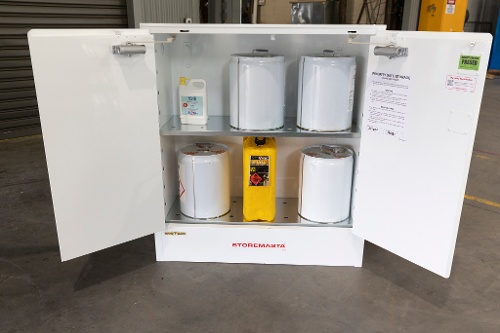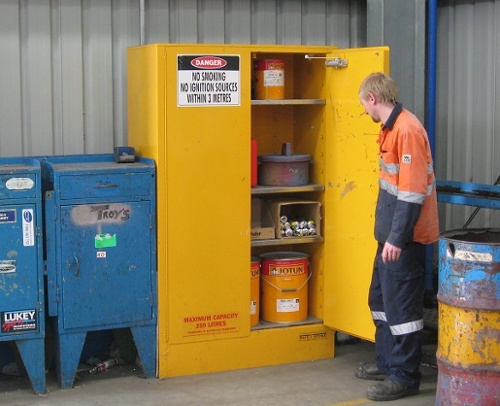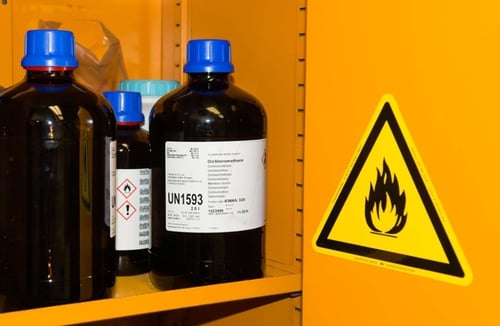It may seem like a simple question, but there are some specific do’s and don’ts when it comes to what you can store in a chemical cabinet. While chemical cabinets (otherwise known as safety cabinets or HAZCHEM storage cabinets) are designed in a range of models for various chemical classes, there are some things that you need to keep in mind when your staff are loading and stacking your cabinet. These considerations aren’t just for efficiency and practicality, they can impact the level of risk associated with the dangerous goods and hazardous chemical in your storage areas.
Understanding Chemical Cabinets
Chemical cabinets are perhaps the most widely used piece of dangerous goods storage equipment. And while that’s a big statement, the risks that they control are even more remarkable.
Cabinet risk controls may include:
- Chemical spill containment
- Hazardous vapour containment
- Heat and fire protection
- Security for stored chemicals
- Protection from impact damage
- Segregation from incompatible substances

From spill containment to segregation from incompatible substances, chemical cabinets reduce the risks associated with hazardous substances.
Cabinets are designed for the storage of dangerous goods and hazardous chemicals in the indoor environment. A cabinet that complies with Australian Standards will feature risk control measures that are specific to the chemical class that its designed to store.
TIP: The Australian Standards, while not law, are a complex set of requirements that specifically apply to the handling and storge of each dangerous goods class. If you don’t follow the requirements of the Standards, you will not be providing the risk controls that are necessary for the safe storage of hazardous chemicals. And, in the event of a workplace incident, such as a fire or chemical spill, you may also find it difficult to prove that you were meeting your compliance obligations — if your storage does not meet these standards.
Considering Chemicals For Storage
The various types of chemical cabinets include models for the storage of:
- Class 1 - Explosives
- Class 3 - Flammable Liquids
- Class 4 - Flammable Solids
- Class 5.1 - Oxidising Agents
- Class 5.2 - Organic Peroxides
- Class 6 - Toxic Substances
- Class 8 - Corrosive Substances
- Class 9 - Miscellaneous Dangerous Goods
Therefore, the first thing to consider when selecting a chemical storage cabinet for your workplace or remote site is to understand the dangerous goods class of your chemical products.

Due to the volatility of dangerous goods, they must be stored in a compliant cabinet that features all the necessary requirements of the Australian Standards.
What Class Can Be Stored?
You can determine the dangerous goods class of each chemical product that you’re looking to store by referring to the Safety Data Sheet (SDS).
Your SDS will provide you with the chemical class, as well as instructions on the handling and storage of your product. You must always store your chemicals in the correct class of cabinet, otherwise, you will not be able to control the risks associated with that chemical class.
For example, corrosive chemicals must be stored in cabinet that offers protection from chemical attack. No other type of cabinet will offer this feature. Likewise, toxic substances must be stored in a cabinet with lockable doors, to prevent theft and misuse of the hazardous chemicals. Flammable liquids, due to the risk of ignition, must be stored in a cabinet that offers protection against heat and fire.
Therefore, always select a cabinet that is designed and constructed for the dangerous goods class of the chemicals that you’re carrying. This will ensure that it’s equipped with the necessary features to minimise the risks that are specific to your chemical products.
TIP: Even the same chemical product, made by different manufacturers, can have different chemical properties and hazards. Always refer to the SDS of each product that you’re storing — and never assume that new products share the same properties or DG class as your existing chemicals.
Are There Compatibility Hazards?
If you delve a little deeper into the issue of chemical storage, you will note that determining the compatibility of chemicals is a key safety issue.
While your compliant chemical storage cabinet offers segregation from other incompatible substances that may be in the same work area, it must not be filled with substances that can react dangerously or that are incompatible. Most classes of dangerous goods are incompatible with many other chemical classes. For example, flammable Liquids must be segregated from all other classes of dangerous goods. Most dangerous goods classes have strict segregation guidelines that prohibit the mixed storage of different chemical classes.
Therefore, what you store in your cabinet should generally be chemicals of the same class — that pose no compatibility hazards.
However, it’s important to note that chemicals that may be incompatible or react dangerously with other products in their own class include:
- Class 5.1 Oxidising Agents
- Class 8 Corrosive Substances
Therefore, you must check the SDS or consult with suppliers to determine if substances of the same class can be stored in the same cabinet.
In addition to these considerations, you should also keep in mind that gases and aerosols should not be stored inside the chemical cabinet. Apart from the compatibility hazards, gases and aerosols require a different type of storage to minimise the hazards associated with these chemicals. Aerosol cages and gas cylinder storage cages are the best option for the safe storage of aerosols and workplace gas cylinders.
TIP: While many classes of dangerous goods are incompatible, there are also particular substances within the same class that may be incompatible. Always refer to the SDS of each chemical product to determine how you should store that particular chemical. And keep the SDS for each product within easy reach of your safety cabinet, preferably within a fixed chemical document holder.
What Packages Can Be Kept In A Chemical Cabinet?
When it comes to the indoor storage of dangerous goods and hazardous chemicals in chemical cabinets, generally the package types may include:
- Chemical containers
- Small drums
- Winchester bottles
- Bags
- Portable containers
TIP: The general storage capacity of a particular cabinet may include the capacity for drums of various sizes. Due to the size of indoor cabinets, drums are usually smaller (up to 60L) in size. However, some larger cabinet models may accommodate a drum up to 205L in size.
While there are a variety of packages that can be kept in your indoor chemical cabinet, you must select a cabinet that meets your capacity requirements.

Consider the type of chemical package that you’re storing, as well as the maximum capacity required for your safety cabinet.
Each model will have the maximum capacity rating clearly displayed on the front of the cabinet. When selecting a cabinet, make sure that the cabinet is large enough to store the volume of chemicals that require storage, as well as the types of packages that you’re carrying.
For example, the number of small drums that you can place in a particular cabinet will differ from the amount of bottles, bags or containers that you can store. Therefore, you need to consider both the capacity and the type of chemical package that you’re storing. If your cabinet doesn’t suit your requirements, choose a larger model or invest in a second cabinet for excess stock.
Remember, never overload your indoor chemical cabinet past its maximum capacity as this can render the risk control measures of the cabinet ineffective and non-compliant.
TIP: You can adjust your cabinet’s shelving to suit the type of packages that you’re storing. Simply take off the adjustable shelf and place to one side. Then remove the 4 lugs in the interior wall of the cabinet and reposition in the preferred place. You can then put the shelf back on the lugs and re-load the cabinet.
Can I Put Wrapped Packages In The Cabinet?
While staff may be pressed for time when handling chemical deliveries and loading them into the cabinet, one thing that should not be put in a cabinet is a wrapped chemical package.
Any packaging from the manufacturer or supplier must be removed before your chemical drums, containers or bottles are placed in the safety cabinet.
This includes the removal and disposal of any tape, plastic, wrap or cardboard that encases the chemical package itself.
Failure to remove the packaging that your chemicals were delivered in can increase the risk of fire within your cabinet. Likewise, any combustibles on or near the cabinet, such as paperwork, rubbish, spill kits or even PPE, can become fuel for a fire.
Therefore, these items should be stored in their own dedicated cabinet (such as a PPE storage cabinet) to reduce risk in your work area.
TIP: It’s a good idea to schedule regular inspections of your cabinet to ensure that the cabinet is being used in the correct manner. This includes checking the chemicals that are being stored, the drums or containers they’re stored in, and any additional materials that are kept in the general work area.
Using Your Chemical Cabinet Safely
While purchasing a compliant chemical storage cabinet that meets the requirements of the relevant Australian Standard is a step towards achieving compliance for your workplace, how you choose to use the cabinet will also affect its ability to control risk. As we’ve highlighted in this blog, make sure that your staff are all aware of what exactly they should be storing in each chemical cabinet in your business.
Different types of chemical cabinets have different control measures that are specifically designed and constructed for that dangerous goods class. Therefore, you should always store the correct chemical products in your cabinet, taking into consideration the possibility that some products may react dangerously with each other or be incompatible. You should also ensure that there is no packaging left on the chemical packages, and that the cabinets are only used to store the appropriate chemical products.
To learn more about how to select and use a compliant safety cabinet, why not download our helpful guide? The Design Requirements For Different Dangerous Goods Storage Cabinets will help you understand your hazardous substances and what you need to do to store them in a safe manner. Grab your copy of our guide for free right now.
Joining the team as a Dangerous Goods Storage Consultant, Melissa Hampton became Storemasta's Marketing Manager in late 2021. With extensive knowledge and experience in chemical compliance, Melissa is responsible for leading the Marketing team and helping shape their marketing strategy. In her spare time, you can find Melissa hiking, swimming and enjoying the great outdoors in beautiful north-west Tasmania.

